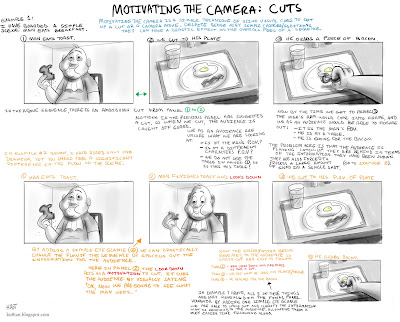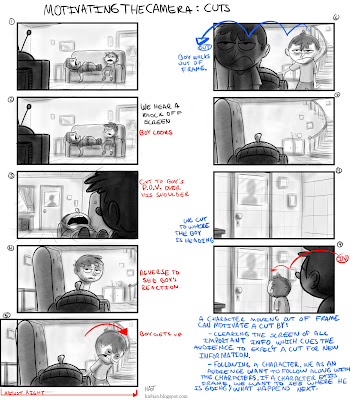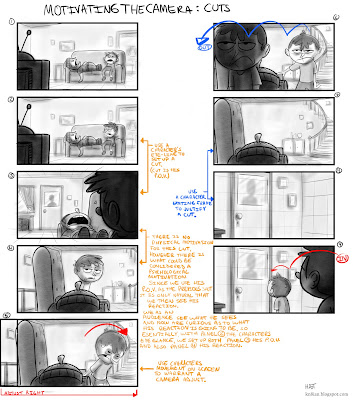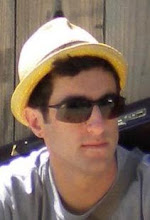Motivating the camera is a simple technique of using visual cues to set up a cut or camera-move and in doing so, ease the audience into a new shot or new information.
Below is a simple example of how utilizing the above theory can have a huge influence on the overall feel/continuity of a sequence.

I think I made it a bit overly-complicated. Just look through each of the examples and feel the difference.
Basically: Use a character's eye line to motivate a cut. It helps ease the audience through the cut and into new information. (While also putting us directly in the character's shoes)
There are many other ways to motivate the camera. Below is a short sequence I've boarded out with various examples all strung together. The idea is to create as much continuity within the sequence as possible, making everything clear and easy to follow.
 Below I have pointed out the specific methods used to motivate the camera.
Below I have pointed out the specific methods used to motivate the camera. So as per the above sequence, ways to motivate the camera;
So as per the above sequence, ways to motivate the camera;- Using a Character's eyeline/P.O.V.
- Having a character move on screen and adjusting the camera accordingly.
- Having a character exit frame.
There are other ways not represented in the above example, for instance;
- Having a character enter frame. (This will be illustrated in a future tip sheet.)
I think ultimately what it comes down to, specifically for 'cutting', is the fact that a 'cut' is not natural, it doesn't happen in real life (unless you take really long blinks). Obviously we have seen enough film/television that we are accustomed to 'cutting', nevertheless, anything you can do to smooth out the transition will only help create and maintain the continuity of your sequence.
To be continued shortly...
* Gold stars are neither gold nor stars and consist almost entirely of your imagination.

3 comments:
Very good info, thanks for posting this. One question, if in example 1 you'd already established the shot of the plate of food and it's spacial relationship to the guy (prior to that first shot in the board), would you still feel the need to motivate the cut with the guy looking downwards? So, for example, if after eating that piece of bacon, he reached down for something else on the plate, would you again use him looking down to guide the audience?
You are very talented and smart. Would have never known that "motivating the camera" - even was a tool/instrument. Just thought it was a flow of sequence.
great stuff Josh! I love to read your tip sheets...
and I do want a gold star.
Post a Comment